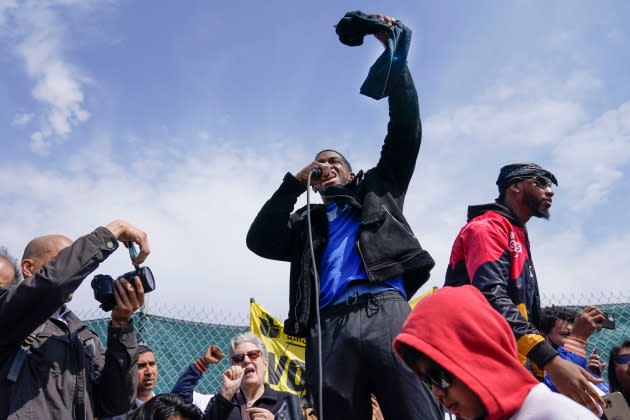Brand Audits ‘Just Camouflage,’ Pervasive Union-busting, Harassment and the Like, Report Says

Union-busting is more than just a bad look for a brand — it’s a breach of workers’ rights.
A new report from the Business & Human Rights Resource Center titled “Unpicked: Fashion & Freedom of Association” found union-busting is on the rise.
More from WWD
“Because of the pandemic, threats to freedom of association were exacerbated….And really importantly, there’s never been a time that’s been more critical for businesses to engage their workers in health and safety in the pandemic,” Natalie Swan, labor rights project manager at the Business & Human Rights Resource Center, told WWD in an interview.
Under the International Labour Organization’s core protections, collective bargaining and the right to form or join a union is protected under law. The Resource Center surveyed 124 union activists in Bangladesh, Cambodia, India, Indonesia and Sri Lanka on a number of prevailing issues in the workplace. The survey collection timeline was from June 2022 to July 2022. Some 61 percent of respondents said collective bargaining agreements have gotten worse, as did myriad other ESG-billed issues.
There was a cited 48 percent rise in workplace discrimination and harassment for trade union members. Other reports indicate union members also experienced surveillance, denial of factory access, violence, blacklisting, dismissal, false charges and strike repression.
In countries like Pakistan and Sri Lanka, the phenomenon is being exacerbated by the ongoing economic crisis.
“Straight after COVID-19 we are now in an economic crisis; we don’t even have electricity during blackouts and inflation for food is over 50 percent,” Anton Marcus, joint secretary of the Free Trade Zones and General Services Employees Union in Sri Lanka, noted in the report. “The workers are struggling to survive, they don’t have time to engage with trade union activities. When we call training programs and meetings, attendance is very poor. They are too busy in the queue in the petrol station to get fuel. It’s having a very bad impact on trade unions.”
Marcus also went on to call the audit system many brands rely on as “just camouflage.”
“It’s not real,” he said. “They don’t share the reports with the unions, they don’t even talk to the unions. We know how [the factories] select the workers for audits, most are non-union members. This system is never going to support workers. If they really wanted to have a genuine audit, they need to talk to the unions. When there is no union, they should talk to the workers at their boarding houses, not inside the factory. Inside the factory, workers cannot talk the truth.”
Benetton Group, C&A, H&M, Mango, Bestseller, Primark, Under Armour, J. Crew, Asda and others were among the brands mentioned in the report’s case studies or union member testimony.
Bangalore-based union leader Namita (whose name has been changed for safety) produces for brands including Benetton Group, C&A and H&M and said the ever-high production targets have made managers unwieldy.
“[The supervisors] throw bundles of clothes at us, every day at one or two people at least. When it hits us in the face, it really hurts. They pull and push us, hold our hands tightly and drag us from the machine across the factory floor and push us to the side,” she said.
The Resource Center is also investigating gender-based violence and harassment claims in a number of factories, engaging in dialogue with a dozen brands.
Swan said the report provides an “evidence-based [approach] to engaging with brands and workers,” and that it can stoke further change.
“We see that brands undertake initiatives along their supply chains often — let’s say gender or modern slavery. Part of the solution is for brands and governments and other stakeholders to take freedom of association seriously. If you don’t respect it, you see a backslide in these issues,” she said. “It’s a solution for brands to champion freedom of association and have brave, bold conversations on the benefits….Brands aren’t keen to talk about freedom of association as they are about gender issues. The second thing is fair purchasing practices, particularly during times of crisis.”
Nearly every brand mentioned in the report has a public commitment to worker safety, said Swan, but the missing piece is often a “sustainable financial commitment to your suppliers.” The report also highlighted the need for binding agreements on pay and freedom of association, like Clean Clothes Campaign’s “Pay Your Workers — Respect Labour Rights” agreement — which does just that.
The last thing Swan mentioned was the gray area of audits, which are just one of many ESG issues under fire for their efficacy.
To that she said, “We know that audits are good at highlighting certain types of risk — it’s relatively easy to spot ‘Is there fire safety equipment? A lock on the bathroom door?’ It requires more substantive investigation by brands. You need to talk to a broader number of people. You can’t always talk to workers in the workplace because they may not feel safe. It’s really tricky, and not always the best.”
As activists, journalists and more can attest, those closest to the situation at hand may be the best to speak on it.
“It’s incredibly important that workers are believed,” Swan reiterated. “If you want to know health and safety, harassment risks on the floor. It’s the workers who are the experts.”
